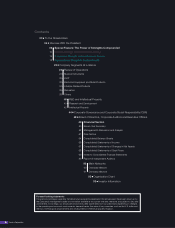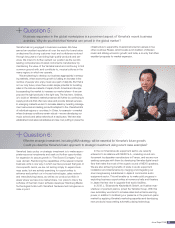Yamaha 2008 Annual Report Download - page 14
Download and view the complete annual report
Please find page 14 of the 2008 Yamaha annual report below. You can navigate through the pages in the report by either clicking on the pages listed below, or by using the keyword search tool below to find specific information within the annual report.
12 Yamaha Corporation
Creative Strength to Enhance Product Value
Technology and Craftsmanship Put the Music Into
Grand Pianos
Yamaha has over a century of experience in making pianos,
dating back to 1900, when Company founder Torakusu Yamaha
built his first piano. Over the years, Yamaha has combined the
latest in technology with its accumulated craftsmanship, striving
to perfect each note according to the most exacting standards
in order to always provide the market with the finest pianos
possible. At its factories, the Company makes use of the most
up-to-date facilities to enhance the quality of its products, such
as anechoic chambers to scientifically study the relationship
between each product’s structure and the sound it generates,
weather-resistance testing rooms to study the impact of
temperature and humidity, and the world’s most advanced
computer-controlled drying equipment.
When manufacturing a grand piano, the most essential fea-
tures are the richness and expressiveness of the notes. To
achieve the highest quality in these areas, our skilled artisans
carefully adjust the key regulation and voicing—a process that
involves carefully adjusting the striking action of each key and
the shaping and positioning of the hammer heads to produce
ideal sound quality. This adjustment requires highly skilled crafts-
manship and refined musical perception, as the entire process is
carried out by hand. These traditions and skills have been
passed down through the Company over a period of more than
100 years. Each Yamaha piano is a product of this experienced
craftsmanship and the constant endeavors of technicians with a
wealth of piano expertise gained through extensive consultation
and cooperation with top-class pianists in Japan and overseas.
Electronics Technology Founded on Experience with
Musical Instruments
Yamaha made an early start in embracing electronics technol-
ogy to develop top-quality digital musical instruments. In order
to reproduce rich and expressive musical notes using electronic
equipment, the Company researched frequency modulation
sound synthesis technology and a range of other digital audio
synthesis technologies, and used them to develop the ElectoneTM,
synthesizers and many other successful digital musical instruments.
The Company also conducted extensive research on sound
processing technologies, learning how to collect, adjust, mix and
amplify the sounds generated by musical instruments. This
research led the Company to develop professional audio (PA)
equipment such as our commercial digital mixers, which have
acquired a very positive reputation in the market.
Yamaha has developed some of the world’s most advanced
sound field reproduction technology, which can electronically
reproduce the acoustic environment of world-famous concert halls
and other music performance venues. This technology has made a
significant contribution as one of Yamaha’s core technologies, and
is incorporated into the Company’s CINEMA DSPTM AV equipment,
as well as in our PA equipment and digital musical instruments.
In order to acquire the processing power needed for sound
synthesis and sound processing, the Company has established
its own semiconductor operations to design and manufacture
these high-performance chips in-house, thereby securing an
overwhelming competitive advantage that rivals simply cannot
match. The success of these endeavors has led to new product
applications in other fields, such as LSI sound chips for PCs and
mobile phones, becoming a major driving force for the Com-
pany’s further innovation.
All of these efforts to develop digital musical products and
applications are supported by research and development which
has generated a wealth of information and know-how, from
sound design technology to a veritable concert of musical instru-
ment data, data on music styles from around the world, and
data on the sound fields of famous concert halls and auditoriums
in many countries. These and many other intangible assets
compiled by the Company over the years provide a foundation
for Yamaha’s competitive advantages as it seeks to further
expand its electronics technology and related businesses.
12 Yamaha Corporation
Crafting Sound
The DX7, whose 1983
launch set off the worldwide
synthesizer boom
























